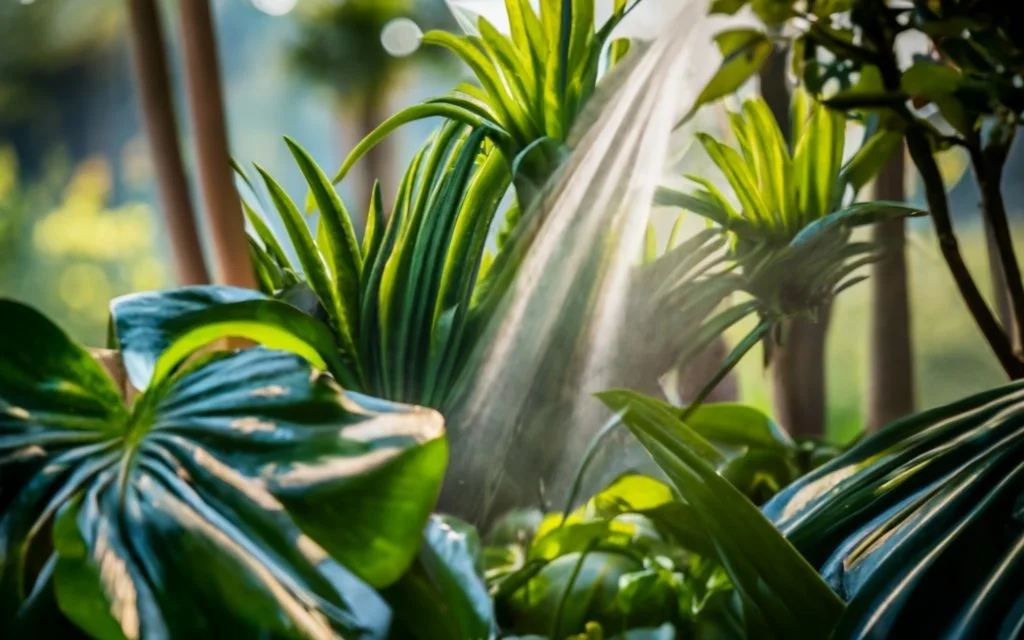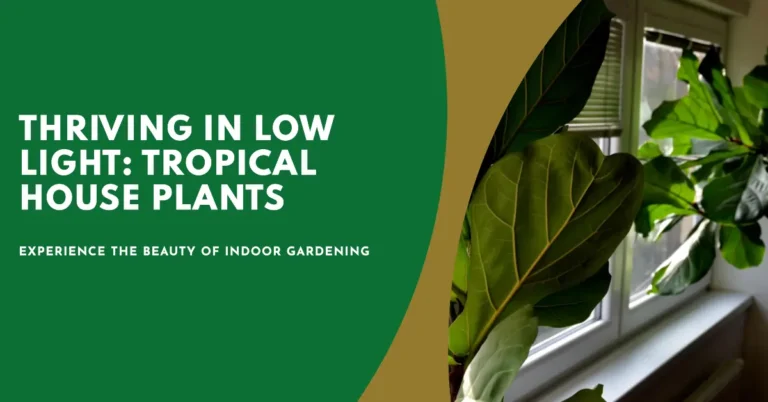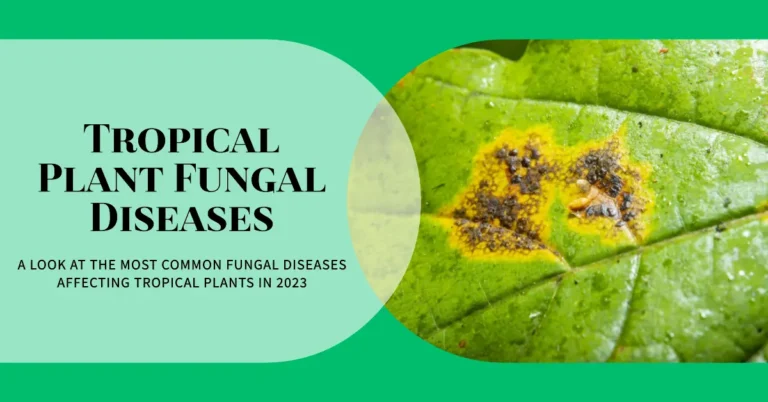Misting Tropical Plants
Master the Art of Misting Tropical Plants for a Lusher Indoor Jungle
Tropical plants are indeed the divas of the botanical world, demanding attention and meticulous care to truly flourish. Central to their well-being? A humidity-rich environment that mirrors their natural habitats is achieved through the art of misting tropical plants.

Why Misting Tropical Plants is Essential
These captivating green beings hail from regions kissed by the equator, where rainfall is no stranger, and the climate is constantly embracing warmth. Imagine the vibrant and steamy jungles; that is precisely the atmosphere your tropical plants yearn for.
Now, you might wonder why is humidity so crucial. It boils down to the plant’s intricate system. Each leaf houses tiny pores known as stomata, responsible for taking in carbon dioxide for photosynthesis. It’s a delicate balance as they can lose water while absorbing CO2, a phenomenon termed as transpiration.
Transpiration and Its Challenges Indoors
Indoor environments, especially during winter, offer a contrasting setting to their native hot and humid habitats, leading to a dry spell. These plants then undergo stress, showcasing signs like browning leaves or wilting.
But fear not, for there is a magic wand to keep your tropical green friends jubilant and lush, and that wand is misting.
The Misting Magic
Here is where misting tropical plants step in as a savior. It not only aids in maintaining the moisture level but brings a piece of their natural habitat indoors. Misting emulates the fine droplets of a soft rainfall, enhancing the humidity around your beloved green companions.
- Frequency: Regular misting can ensure a happy and healthy plant.
- Technique: Use a fine mist sprayer for even moisture distribution.
- Timing: Misting in the morning hours is often recommended.
Conclusion
To nurture and see your tropical plants thrive:
- Re-create their natural habitat indoors through meticulous misting
- Understand their inherent need for high humidity levels
- Make misting a routine, not a chore
Misting tropical plants is not just a process but an artistic venture, promising healthy growth and vibrancy in your indoor tropical plants. Embrace the joy of seeing your green space flourish as you master the art of misting. It is time your indoor jungle reflected the true essence of a tropical paradise, brought to life through the magic of misting.
The Role of Water Mist in Mimicking Tropical Climates
Water mist plays a crucial role in creating the perfect environment for tropical plants. You see, these green buddies hail from parts of the world where humidity levels are high and rainfall is frequent. So, when we bring them into our homes, they crave that same moisture-rich air they’re used to. That’s where water mist comes in handy! It helps recreate their native habitat by increasing the humidity around them.
Now, you might wonder how exactly this works. Well, it’s pretty simple, actually. When you spray a fine mist of water onto your plant’s leaves and surrounding air, it evaporates slowly over time. This process mimics the natural evaporation cycle in tropical climates – just like a mini rainforest on your living room shelf!
But remember folks – while regular misting can be beneficial for many tropical plants like ferns or orchids, some may not appreciate being drenched all the time (think succulents). Also, watch for signs of over-misting, such as yellow leaves or mold growth – because too much love can sometimes hurt more than help.
Devising a Misting Schedule for Your Green Friends
Creating a misting schedule for your tropical plants isn’t as complex as it might sound. It all begins with understanding the specific needs of each plant species you have in your indoor jungle. Some plants prefer daily light misting, while others may only require bi-weekly or even weekly sessions. Remember that this is not about drenching your green friends but rather providing them a refreshing and humid environment akin to their natural habitat.
It’s also important to consider factors such as the time of day and season when devising a misting schedule. Mornings are generally ideal for most tropical plants since it mirror the dewy conditions they would experience in nature. Seasons can affect indoor humidity levels, too, so you might need to adjust your routine during winter or summer months accordingly.
One tip that could be handy is keeping track of how well each plant responds after being misted. This way, you get to understand their preferences better over time and make necessary adjustments if needed. For instance, if leaves start yellowing or wilting despite regular watering and feeding, these could be signs of over-misting that warrant changes in your routine. Just remember: moderation is key!
The Right Way to Mist Your Indoor Jungle
Misting your indoor tropical plants isn’t rocket science, but it requires some knowledge and finesse. The key is to mimic the natural humidity of a plant’s native environment without drenching its leaves or creating conditions that encourage mold growth. For starters, always use room-temperature water for misting. Cold water can shock delicate plant tissues, while hot water may cause wilting.
Now let’s talk about technique! When you’re ready to mist, hold your spray bottle about 6 inches away from the foliage and aim for a light spritz rather than a heavy soak. Try not to directly hit flowers as this could potentially damage them. Remember – we’re going for dewy morning freshness here, not a monsoon downpour!
The timing is equally crucial in this process. The best time to mist is usually early in the morning when evaporation rates are low, but sunlight can still help dry out any excess moisture on leaf surfaces throughout the day. This reduces the chances of fungal infections, which thrive in damp conditions overnight! Also, remember that different plants have varying needs, so adjust your routine accordingly; ferns love daily mists, while others, like snake plants, prefer their leaves kept dry most times.
The Science Behind Misting: Benefits for Tropical Plants
Misting is more than just spraying water on your tropical plants. It’s about mimicking the humid, dew-drenched environment in which these plants naturally thrive. Most tropical plants are native to rainforests where humidity levels can reach up to a whopping 90%.
So when we bring them into our homes, they often struggle with the dry air and lack of moisture. That’s where misting comes in! By providing a fine spray of water droplets onto the plant leaves, you’re essentially creating a mini rainforest atmosphere for them right at home!
But how does this benefit your green friends? Well, it all boils down to their natural adaptation for survival in high-humidity environments. Tropical plants have evolved features like large leaf surfaces and aerial roots specifically designed to absorb as much moisture from the air as possible.
When you mist these plants regularly, you provide them with an additional source of hydration apart from regular watering at their roots.
Moreover, misting also helps keep dust off your plant’s leaves which aids in photosynthesis – the process by which they convert light energy into chemical energy for growth and development.
Dusty leaves can block sunlight and reduce a plant’s photosynthetic efficiency leading to slower growth rates or even deterioration over time. So not only does misting replicate their natural habitat, but also supports optimal health and vitality of your indoor jungle!
Homemade Misting Solutions and Their Effectiveness
Creating your own misting solution can be a fun and cost-effective way to care for your tropical plants. All you need is some distilled water, a pinch of Epsom salt, and a few drops of natural dish soap. The distilled water ensures that no unwanted minerals or chemicals could harm the plant’s delicate foliage. The Epsom salt provides magnesium, which helps with chlorophyll production in the leaves.
The addition of natural dish soap might raise eyebrows, but it serves an important purpose! It acts as a surfactant; basically, it reduces the surface tension of water, allowing it to spread more evenly on the plant’s leaves, mimicking dew formation in their native habitats. However, remember moderation is key here – too much soap can damage your green buddies!
Now let’s talk about effectiveness. Homemade solutions have been found effective by many indoor gardeners around the world who swear by this DIY method for its simplicity and affordability. But keep in mind each plant species has unique needs, so what works wonders for one may not work as well for another. A good rule of thumb is to observe how your plants react to different compositions of homemade misting solutions over time before deciding what suits them best!
Choosing the Ideal Misting Tools and Techniques
To begin with, let’s talk about the different types of misting tools available in the market. Handheld sprayers are quite popular due to their affordability and ease of use. These usually come with adjustable nozzles that allow you to control the intensity of your mist, perfect for smaller indoor plants or a select group of tropical greens. Consider investing in an automatic mister or humidifier if you’re dealing with a larger collection. They can cover more ground and maintain a consistent level of humidity, especially beneficial during drier months.
Moving on from there, it’s not just about what tool you use but how you use it that matters too! The technique is key when it comes to mimicking those tropical climes indoors. When using handheld sprayers, aim for a light mist rather than soaking your plants completely – remember, we’re trying to simulate dewy tropics here! Try spraying from above like rainfall or at an angle to mimic morning dew settling on leaves. For automatic systems, position them strategically so all your green buddies benefit equally without any getting excessively watered.
Now let’s touch upon choosing between DIY homemade solutions versus store-bought ones for your misting needs. It’s tempting to reach out for that spray bottle filled with tap water but hold up; not all water is created equal! Tap water often contains chlorine which might harm sensitive plant species, while distilled or rainwater are generally safer bets as they don’t contain such potentially harmful elements.
So, let’s summarize the important points to consider when choosing your ideal misting tools and techniques:
• Opt for handheld sprayers if you have a small collection of indoor plants or specific tropical greens. They are affordable, easy to use, and come with adjustable nozzles for controlling the intensity of your mist.
• Consider automatic misters or humidifiers for larger plant collections. These can cover more ground and maintain a consistent level of humidity which is especially beneficial during drier months.
• Pay attention to what tool you use and how you use it. The technique is key in mimicking those tropical climes indoors.
• When using handheld sprayers, aim for a light mist rather than soaking your plants completely – remember, we’re trying to simulate dewy tropics here!
• Try spraying from above like rainfall or at an angle to mimic morning dew settling on leaves when using handheld sprayers.
• For automatic systems, position them strategically so all your green buddies benefit equally without any getting excessively watered.
And finally,
• Be mindful about the type of water used in your mister. Tap water often contains chlorine which might harm sensitive plant species, while distilled or rainwater are generally safer bets as they don’t contain such potentially harmful elements.
Remember that proper care and maintenance go hand-in-hand with having healthy indoor plants!
Preventing Over-Misting: Signs and Solutions
It’s a common mistake to think that more misting equals happier tropical plants. However, over-misting can lead to problems such as leaf rot, fungal growth, and even pest infestations. You don’t want your indoor jungle turning into an unhealthy swamp! So how do you know if you’re going overboard with the water spray? Well, one tell-tale sign is yellowing leaves. If your plant’s leaves start to turn yellow or brown at the edges, it could be a symptom of too much moisture.
Now let’s talk about solutions because we all love our green friends and want them in their best health! First things first – cut back on the misting. Instead of dousing them daily, try reducing it to every other day or twice a week, depending on the humidity levels in your home environment. Remember that many tropical plants are used to periods of rain followed by dry spells, so they appreciate some time between watering sessions!
Another effective solution is increasing ventilation around your plants which aids in evaporation, thereby preventing excess moisture from settling on the foliage for long durations. Consider placing them near open windows or using fans (on low setting) for air circulation but make sure they’re not directly under cold drafts as it might shock these heat-lovers! Also, remember that balance is key here; while we are trying to prevent over-misting issues, under-watering isn’t beneficial either – keep observing and adjusting according to your plant’s needs.
Impact of Seasonal Changes on Misting Practices
One thing that’s really interesting about tropical plants is how they react to seasonal changes. You see, even though these lush beauties hail from regions where it’s warm and humid year-round, they still have their own unique ways of adapting when the seasons change in your home environment. This can definitely affect how often you mistreat them.
Consider winter, for example. As temperatures drop outside, we tend to crank up our heating systems which unfortunately suck out a lot of moisture from the air inside our homes. This can leave your tropical buddies feeling pretty parched! To compensate for this dryness, you might need to increase your misting frequency during these colder months so as not to deprive them of the humidity they crave.
On the other hand, summer brings about an entirely different scenario. With increased heat and natural humidity levels going up, over-misting could become a problem if you’re not careful enough. In fact, too much water can actually harm your plants more than help them by creating an ideal breeding ground for mold and fungi – yikes! So while it’s always important to keep tabs on how thirsty your indoor jungle appears, remember that moderation is key, especially when seasons change.
Misting Myths Debunked: Common Misconceptions about Plant Hydration
One of the most common myths about plant hydration is that all plants need to be misted. While it’s true that tropical plants thrive in humid conditions, not every indoor plant falls into this category. Some houseplants hail from arid regions, and too much moisture can actually harm them. It’s always best to research your specific type of plant before starting a misting regimen.
Another misconception is that you should mist your plants daily. This can lead to overwatering and potentially root rot, which could kill your beloved green friends! The frequency of misting depends on your plant’s specific needs and environmental factors such as humidity levels in your home or office space. A bi-weekly spritz might suffice for some tropical varieties, while others may require more frequent attention.
A rather surprising myth surrounding the practice of misting involves using cold water for this purpose. Many believe that since rainwater tends to be cool, it would make sense to replicate these conditions when hydrating our indoor jungles. However, using room temperature water is typically recommended for most plants as sudden changes in temperature can cause stress leading to leaf drop or wilting.
FAQs
What is the importance of humidity for tropical plants?
Humidity plays a crucial role in the growth and survival of tropical plants. It helps in maintaining moisture in the leaves and stems, promoting the process of photosynthesis and overall plant health.
How does water mist mimic tropical climates for indoor plants?
Water mist creates a humid environment for the plants, much like their native tropical climates. This moisture-rich atmosphere helps the plants to absorb water through their leaves, supplementing their hydration needs.
How often should I mist my indoor plants?
This largely depends on the specific needs of your plant species, the season, and the humidity level in your home. However, misting your plants every two to three days is a general rule of thumb.
How should I properly mist my indoor plants?
The ideal way to mist your plants is to spray water in a fine mist around the plant, focusing on the leaves and avoiding the soil. This helps to replicate the humid, dewy environment found in tropical areas.
What are the benefits of misting tropical plants?
Misting provides extra moisture that helps tropical plants to flourish. It helps in preventing leaf desiccation, encourages better growth, and can help deter certain pests.
Are homemade misting solutions effective?
Homemade misting solutions can be effective, but using the right ingredients is important to avoid damaging your plants. Always research the needs of your specific plant species before trying a homemade solution.
What tools should I use for misting my plants?
A simple spray bottle with a fine mist setting is normally sufficient for misting plants. However, a larger pressure sprayer or even a humidifier might be more effective for larger plants or collections.
How can I prevent over-misting my plants?
It’s important to monitor your plants closely for signs of over-misting, such as yellowing leaves or mold growth. If you see these signs, reduce the frequency of misting and consider other sources of excess humidity.
How do seasonal changes impact misting practices?
Seasonal changes can affect the humidity levels in your home. In drier seasons or climates, you might need to mist more frequently. Conversely, you might need to reduce your misting in humid seasons or regions.
What are some common misconceptions about plant hydration and misting?
Some people believe that misting can replace watering, which is not true. Misting is supplemental to watering. Another misconception is that all plants benefit from misting, when in fact, some plants, like cacti and succulents, prefer dry conditions.







